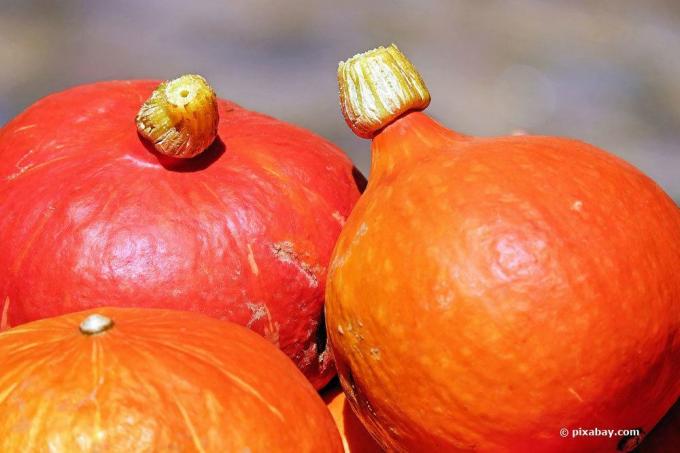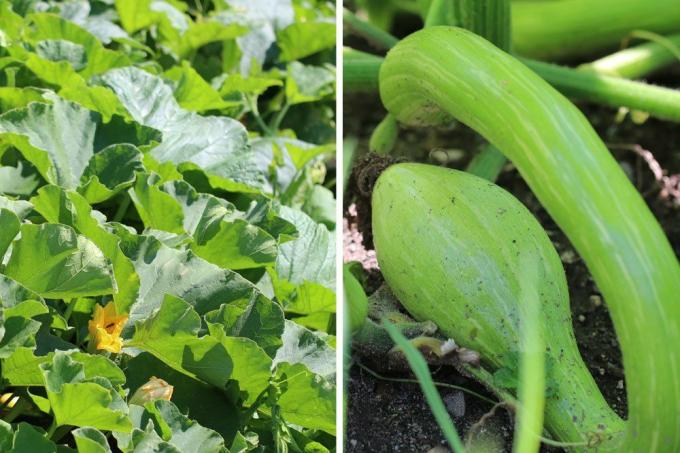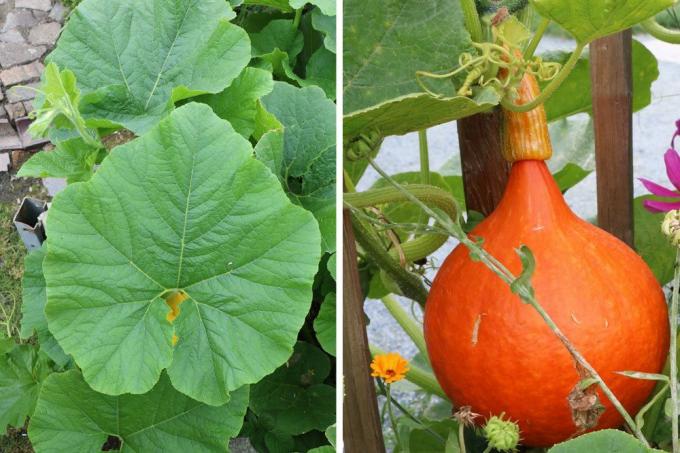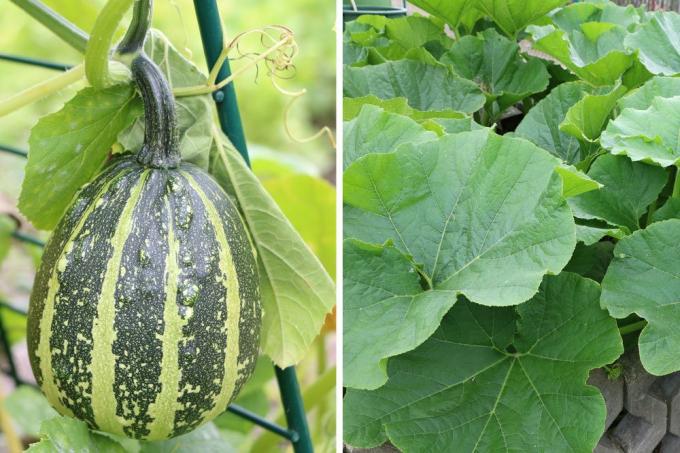
table of contents
- Pumpkin varieties
- Baby boo
- Bishop's cap
- Butternut
- Hokkaido
- Howden pumpkin
- nutmeg
- Patisson
- Spaghetti Pumpkin
- useful information
Pumpkins, which from a botanical point of view belong to the berry fruits, come in different sizes, Shapes and colors, with the largest types of pumpkin weighing several hundred kilograms can. In addition, a distinction is made between edible pumpkins and smaller, poisonous decorative pumpkins. The selection of pumpkins is huge, with some types of pumpkin, thanks to their taste and their various processing options are particularly popular, as the following overview shows.
Pumpkin varieties
Baby bear
One of these types of pumpkin is the baby bear pumpkin. As the name suggests, it is rather small with a diameter of 10-12 cm and a fruit weight of 500-900 g. It is characterized by its round, brownish-orange and slightly ribbed shape and its dark yellow flesh. A plant develops around 5-8 fruits, the ripening time is around 100 days.
The Baby Bear is not particularly robust and its durability is comparatively poor. This particularly high-yielding variety can be stored for 2-3 months. Harvest time is from August to November. This pumpkin can be used very well for making jams, soups, cakes and for filling. It is also very suitable for carvings, for example for Halloween.
Baby boo
With a weight between 100 and 200 g, the Baby Boo is also one of the smaller types of pumpkin. Its white to cream-colored shell and the flat-round, slightly ribbed shape, the counterpart to the orange Jack be little, are striking. Its fruits, which are ripe between September and October, reach a diameter of just 5-8 cm and a height of 3-4 cm.
The flesh is about 1 cm thick, floury-sweet and crunchy with a nutty, chestnut-like aroma. It can be eaten raw and with its shell, filled, deep-fried or gratinated. In addition, it works well for decorative purposes. The ripening time is around 95 days and the long shelf life of up to seven months is impressive.

Bishop's cap
The bishop's hat, also known as the Turk's turban, is one of the types of pumpkin that is both decorative and edible. This flatter, round pumpkin owes its name to its unusual shape, which resembles a bishop's cap or a turban. Responsible for this are adhesions in which the ring-shaped central part, the flower base, usually has a different-colored, bulging fruit pulp.
The most important things about the Bischofsmütze here in a small overview:
- Bischofsmütze is the collective term for other sub-varieties
- these pumpkin varieties differ mainly in their coloration
- they produce fruits weighing up to 2 kg
- In contrast to other types of pumpkin, only the pulp is edible here
- the peel is inedible
- The pulp has a strong, aromatic taste
- Can be kept for up to 6 months if stored in a cool, dry place
- Pulp is mainly used for soups
- Hollowed out bowls can be used for serving
Butternut
The butternut squash is one of the so-called musk squash and is one of its most famous representatives. It has the elongated shape of a pear with a yellowish to pale yellow skin and can weigh 1-2 kg. There are also numerous sub-types of butternut. It owes its great corpulence to its buttery to nutty aroma and the sweetish, quite spicy and creamy taste.
This pumpkin contains only a few seeds, so the pulp is particularly productive. It can be peeled easily and can be stored for up to a year. It is suitable for all types of preparation. Like many other types of pumpkin, it can be processed raw into salads and is ideal for roasting, baking, stewing, for soups or to refine Asian dishes.
Tip: Both the aroma and color of the pulp become more intense during storage. Another advantage of this variety is the comparatively high content of carotene.
Yellow hundredweight
The yellow centner, also known as the giant centner, is a classic representative of the giant pumpkin genus (Cucurbita maxima) and, with a weight between 20 and 50 kg and a diameter of around 50 cm, is one of the largest Pumpkin species. As a rule, it is flat-round, noisy and fluted with a yellow-orange color.
The bright yellow and very water-rich flesh is protected by a hard shell that must be removed before consumption. It has a mild aroma and can be used very well in raw vegetable salads, soups, casseroles, jams, compotes or cakes. In addition, it is one of the types of pumpkin that is perfect for carving eerily beautiful pumpkin faces. The yellow hundredweight can be stored for 2-3 months at temperatures of at least 15 degrees.
Hokkaido
In an overview of the most popular pumpkin varieties, Hokkaido from Japan should not be missing. It is one of the giant pumpkins, although it remains relatively small with an average weight of 1-2.5 kg. It is also known as a chestnut or onion squash.
- Hokkaido pumpkin has a broad, onion-like shape
- Pumpkin has an intense orange color
- The shell is relatively hard when raw, but becomes soft when cooked
- The pulp is firm and poor in fiber
- It is harvested in late summer or autumn
- definitely harvest before the first frost

As long as the outside of the pumpkin is intact or If the bowl is completely closed, it can be stored for up to 6 months at temperatures around 10 degrees. Its nutty taste, somewhat reminiscent of chestnuts, unfolds in soups, desserts, gratins or when gratinating. It can also be filled without any problems. For those new to pumpkin cultivation, the Hokkaido is the perfect entry-level pumpkin.

Tip: Clear signs that a pumpkin is ready for harvest are a hard shell, a hollow sound and a woody stem. Speaking of stem; If the pumpkin is to be stored, it is important that a stalk about 5 cm long always remains on the pumpkin.
Howden pumpkin
The Howden pumpkin is a breed from the 1970s. It has a round shape, flattened at the top and bottom, and a slightly ribbed surface. Its average size is 25-35 cm. In addition, it weighs up to 12 kg. The thick, light orange pulp is usually of very good quality and has a fine, slightly sweet pumpkin aroma.
Like many other types of pumpkin, the Howden pumpkin is also very suitable for making soups, jams, purees and cakes. 2-4 fruits are formed per plant. It takes about 115 days to harvest. This pumpkin can then be kept for 4-6 months at temperatures between 10 and 15 degrees.

Jack be little
Jack be little is one of the particularly decorative types of pumpkin. In addition, it is a very tasty pumpkin. Outwardly, Jack be little, one of the mini pumpkins, is the orange counterpart to the white Baby Boo. It is flat and round with a deeper stem and a diameter of 7-9 cm.
Its weight is between 150 and 350 g. Each plant bears around 5-8 fruits. Its slightly sweet taste comes very close to that of the Hokkaido pumpkin. However, here the shell must be prepared before consumption or removed for further processing. When consumed raw, the Jack be little is quite crunchy, cooked or cooked it has a slightly floury consistency. It takes approx. 95 days. Leave a small stalk on the fruit when harvesting.
nutmeg
Like butternut, the nutmeg pumpkin belongs to the musk pumpkin group and is the largest representative of this genus. It owes its name to the spicy nutmeg scent that it gives off after slicing.
Here are the most important facts in a small overview:
- it has a flat, round, plump and very strongly ribbed shape
- Initially green skin and beige-orange-brown as it matures
- Nutmeg squash can weigh up to 35 kg
- it contains only a few nuclei
- The skin is not as hard as that of other pumpkins
- the flesh is strong orange to salmon-colored and has fine fibers
- it is very aromatic with a fruity-sour taste
- in the case of young pumpkins, the peel is also edible
- in the case of older specimens, the shell must be removed
- Nutmeg squash can be eaten raw or cooked
- it gives soups, desserts and salads a special touch
- Can be kept for up to six months if stored in a cool, dry place
Tip: In terms of taste, the Mauskat squash is an exception in that it tastes best when it is not yet fully ripe.
Patisson
The small patisson is one of the flattened types of pumpkin. Its lenticular and flat shape is reminiscent of a UFO or a discus. There are plain white, yellow or green specimens of Patisson, but also those with green stripes or yellow and green spots. These pumpkin varieties can reach a diameter of 7-20 cm. They are usually harvested in an unripe state. Then they are the most tender and tasty and you can also eat the very delicate skin. The older they get, the harder the shell becomes.

Older fruits are usually not inedible, they are usually a bit woody. That is why young fruits in particular are considered a delicacy, be it raw but also fried, braised, steamed or boiled. They do not have to be peeled and can be eaten or taken with the seeds. are processed. The rather tasteless patisson is also very suitable for pickling, as a vegetable preparation or for filling. Regular harvesting leads to the formation of new flowers and fruits.
Pink Jumbo Banana
This pumpkin is an insider tip among pumpkin lovers. According to its name, it resembles an oversized approximately 40 cm long banana in an extraordinary piggy pink. Not infrequently, this pumpkin can reach a weight of 30 kg, with weights of 5-20 kg being the rule. The dark yellow to orange flesh is of excellent quality. It is firm, thick, dry and extremely sweet with a subtle pumpkin taste.
It takes about 100 days for it to reach full maturity. In the kitchen, the Pink Jumbo Banana can be made into all imaginable dishes, from soups and purees to vegetables, gratin and casseroles to roasts, cakes and jams. This pumpkin can be stored for 3-4 months under optimal conditions.
Red hundredweight
Like the yellow hundredweight, the red hundredweight is one of the large pumpkin varieties. It has a flat, round, ribbed shape and can weigh up to 10 kg. The skin is reddish orange and the flesh is orange and is also very rich. It is fine-grained, somewhat watery and slightly sweet in taste. The fruits can be used to make delicious raw vegetable salads, soups, casseroles, vegetables and jams and they are ideal for pickling. The first fruits can be reached after approx. 80 days to be harvested. They can be stored for several months.
Spaghetti Pumpkin
At first glance, the spaghetti pumpkin is reminiscent of a melon. It is one of the finest types of pumpkin, has an oval shape and a smooth, pale yellow skin with elongated green stripes. The fruits reach a diameter of 20-30 cm. The yellow to orange-colored pulp delights with a nut-like, slightly sweet taste.
While the pumpkin is rather inconspicuous on the outside, a real surprise awaits inside, from which the spaghetti pumpkin owes its name. After cooking, the fibrous pulp forms spaghetti-like threads that can be served like normal spaghetti. Usually this pumpkin is cooked whole. It can be stored for a maximum of 3 months.
Sweet dumpling
With a diameter of 8-10 cm and an average weight of approx. 600 g sweet dumpling is one of the smaller types of pumpkin. It has a round, ribbed shape and is cream-colored with dark green stripes. The yellowish flesh is firm, robust, fine and not fibrous. It has a sweet and nutty, chestnut-like taste with a subtle pumpkin aroma. Sweet dumpling does not have to be peeled. In addition to processing in soups, it can be used for grilling, desserts, cakes and tarts, but it can also be prepared like fried potatoes. It can be stored for a maximum of 2 months.

useful information
What to know about pumpkins
The previous overview contains only a small part of the types of pumpkin and pumpkin varieties that are suitable for growing in the garden. Their pulp is not only tasty, it also contains many valuable ingredients, another reason to grow pumpkins in the garden. With intact skin, they can be stored for weeks or months, depending on the variety.
Avoid planting them next to cucumbers and dill if possible. Planting with potatoes, corn, kohlrabi or marigold is better. When buying pumpkins, you should use smaller specimens with a stem if possible. As a rule, their pulp is firmer and less fibrous. In addition, the taste is more intense than that of larger fruits.
In contrast to types of pumpkin, which are suitable for consumption, ornamental pumpkins are only suitable for decoration, which is due to the poisonous bitter substance cucurbitacin. If you're not sure what type of pumpkin it is, a simple taste test can help. To do this, you take some pulp in your mouth. If it tastes bitter, the bite should be spit out immediately, because then this pumpkin is inedible.

